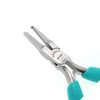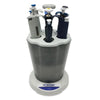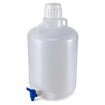- No products in the cart.
Ultimate Guide to pH Calibration
Jun
28
2022
pH refers to the concentration of hydrogen ion activity in an aqueous solution and calibration refers to the comparison between 2 measurements. The acidity or alkalinity is expressed as a value known as the pH.
Acidic solutions have a pH that is less than 7, basic solutions have a pH that is greater than 7, and the pH of 7 is considered neutral. pH meters are used to determine the alkalinity or acidity of a substance.
However, for the meter to be accurate, it must be calibrated using buffers. Buffers are substances with a known pH.
How Does a pH Meter Work?
A pH meter consists of two electrodes. Both electrodes are submerged into a solution. The glass electrode probe measures the quantity of hydrogen ions by emitting a small voltage so see how many hydrogen ions are attracted to it. The reference probe is just electrically neutral.

The difference between the charges of the two probes is the pH measurement which is indicated on the meter. pH meters measure the potential electrical activity produced by the solution which is then compared to known solutions.
What is the pH Meter Principle?
To calibrate a pH meter, measuring substances with known levels of pH are used. These substances with known pH levels are called buffers. The pH measurements of the buffers are then set on the pH meter. These settings are used as a guide when measuring other substances. Every time a pH meter is used, it loses some of its accuracy so it’s important to calibrate a pH meter often.
How Do You Calibrate a pH Tester?
Following are the steps necessary for pH calibration:
- Turn the pH meter on, clean the electrodes by rinsing with distilled water, and wipe clean with a tissue that is lint-free.
- Submerge the electrode into the buffer solution that is pH7. Press the button to calibrate and wait until the pH icon stops flashing. Accept if the pH indicates a 7. If it doesn’t, repeat steps 1 and 2.
- This time submerge the electrode into the pH 10 buffer solution. When the pH icon ceases to flash, press the calibrate button. If the pH is 10, then accept. If not, repeat steps 1 and 3.
- Now you can measure the pH of other substances by using at least two buffers. One buffer should be above and the other buffer should be below the expected pH. Then submerge the electrode into the other substance and press the button to calibrate. Just be sure to submerge and rinse the electrode with distilled water after every sample.
What is a 3 Point Calibration pH Meter?
The only difference in a 3 point calibration pH meter is the number of points checked for accuracy. The 2 point calibration uses 2 buffers; one that is above and one that is below the expected pH. The 3 point calibration consists of 3 buffers that include a low, middle, and high pH level. This results in greater accuracy over a larger range.
Why is pH Calibration Needed?
It’s important when using a pH meter to carry out the step of calibrating the pH meter. The pH electrode measurement is based on the Nernst Equation which takes slope and offset into account. Due to aging and use, electrodes change over time and need to be regularly calibrated back to its optimal performance. Calibration is essential to ensure accurate and repeatable readings.
Where to purchase pH Meters
Lab Pro offers a large variety of medical device manufacturing tools. For over 40 years, Lab Pro Inc. has been committed to delivering the highest quality pH meters, hand tools, chemicals, lab equipment, distance learning kits, lab supplies, and cleanroom PPE apparel to medical device companies and laboratories worldwide. To learn more, visit the biggest Lab Supply showroom in California, or contact us online or at 888-452-2776.














































